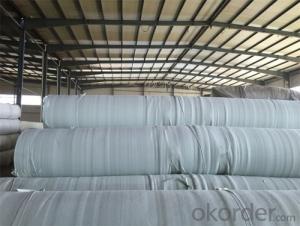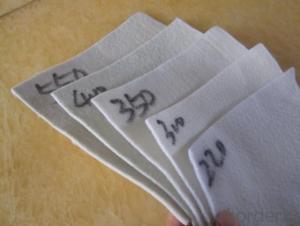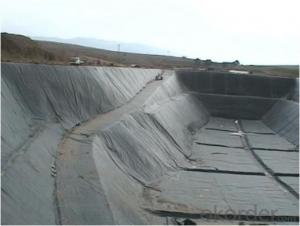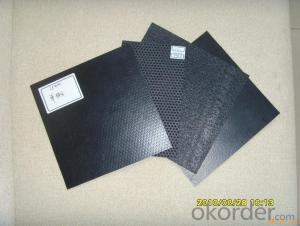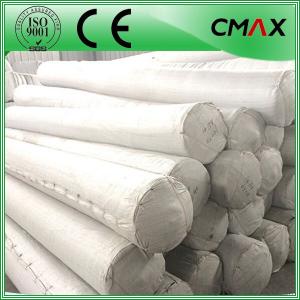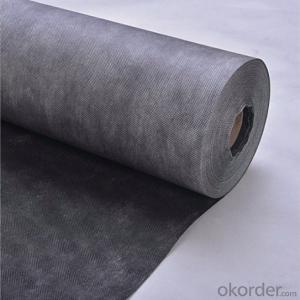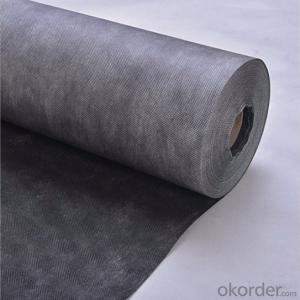Geotextile Continuous Filament Spunbonded Nonwoven Style
- Loading Port:
- Qingdao
- Payment Terms:
- TT or LC
- Min Order Qty:
- 2000 m²
- Supply Capability:
- 800000 m²/month
OKorder Service Pledge
OKorder Financial Service
You Might Also Like
Continuous Filament Spunbonded Nonwoven Geotextile
Introdcution of Continuous Filament Spunbonded Nonwoven Geotextile:
Made from virgin PET (polyester) chips, the continuous filament was extruded from PET chip by machine directly by spunbond process, and then punch together to get the stable 3D with higher strength fabric. So it has high strength, good creep property excellent and erosion resistance, aging-resistance and heat resistance.
Specifications of Continuous Filament Spunbonded Nonwoven Geotextile:
•100g/m2—800g/ m2
•4m—7m in roll width
the length as clients’ request
Production Standard:
GB/T17638-1998
Jt/t 520-2004
Advantage of Continuous Filament Spunbonded Nonwoven Geotextile:
Good creep property and hydraulics property, resistance to corrosion, excellent anti-aging and heat-resistance quality.
Applications of Continuous Filament Spunbonded Nonwoven Geotextile:
• Filtration of soils in drainage applications by retaining soil particles while allowing for the free flow of water.
•Separation and stabilization in road and railway construction
•Prevention of soil movement in erosion control measures
•Cushioning and protection in many containment projects
FAQ:
1. Which payment do you accept?
For you convinience,our payment can be L/C,TT
2. Is free sample available?
We can supply free samples. You'll just need to pay for express cost.
3. How about your quality?
We have strict quality control system, we make testing on incoming raw material and finished products. Your third party testing is also welcomed. With high quality, our products are used on government projects at home and abroad. Our product quality is accepted by clients from all over the world.
Photos of Products and Factory:
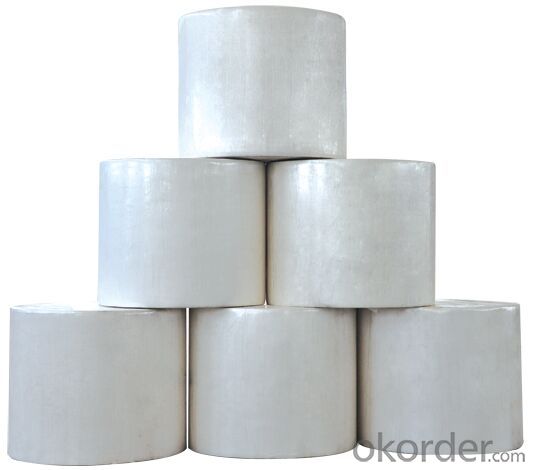

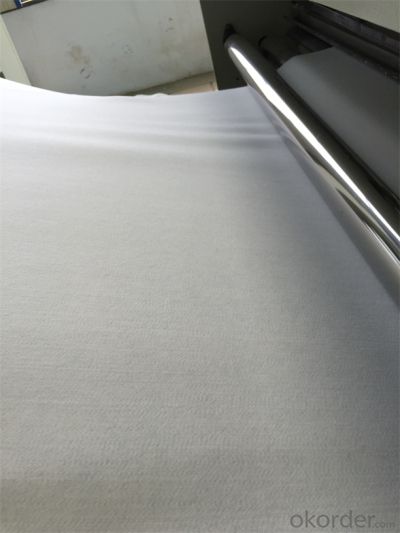

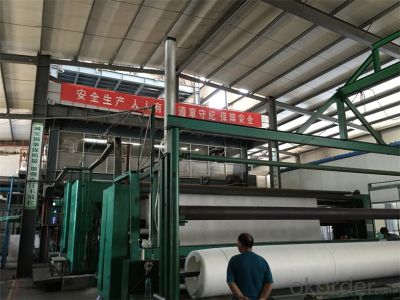
- Q:What are the different geotextile puncture resistance test methods?
- There are several geotextile puncture resistance test methods, including the ASTM D4833, ASTM D6241, and ISO 12236. These methods involve subjecting the geotextile to various mechanical forces to determine its resistance to puncture.
- Q:Are geotextiles suitable for use in railway ballast stabilization?
- Yes, geotextiles are suitable for use in railway ballast stabilization. Geotextiles help to improve the strength and stability of the ballast layer by preventing the migration of fines and providing reinforcement. They also help to distribute loads evenly, reduce track settlement, and increase the overall lifespan of the railway track.
- Q:Geotextile and geogrid difference
- Different geotextile used to prevent seepage, geogrid used to reinforce the geotextile is mainly used to seepage, isolation, geogrid are generally used in reinforced reinforcement, the two are essential differences in the use of the process Sometimes used in the same project, such as high-speed, railway and other engineering production grid is made of polypropylene, polyvinyl chloride and other polymer polymer by thermoplastic or molded two-dimensional grid or a certain height of the three-dimensional Dimensional grid grid, when used as a civil engineering, known as geogrid. Engineering applications: roads, railways, abutments, approach roads, docks, dams, slag and other soft soil foundation reinforcement, retaining walls and road surface cracking engineering and other fields. Fiberglass mesh used in the external walls, wall paint, the main material to prevent the junction of different mortar and other plastering material cracking, hollowing. Local node reinforcement will also be used. Geotextile has excellent filtration, drainage, isolation, reinforcement, anti-seepage, protection, with light weight, high tensile strength, good permeability, high temperature, anti-freeze, anti-aging, corrosion resistance. Common non-woven fabrics, water layer inside the use, polyethylene polypropylene waterproof also used.
- Q:How are geotextiles tested for permeability?
- Geotextiles are tested for permeability using standard laboratory methods, such as the constant head or falling head permeability tests. These tests involve measuring the flow of water through the geotextile under controlled conditions, allowing engineers to determine its permeability and suitability for various applications.
- Q:Do you have a drainage board and a geotextile?
- How many dishes? Drainage board and geotextile a square need about 15 yuan cost, their trade-off
- Q:Can geotextiles be used in the protection of underground cables and pipes?
- Yes, geotextiles can be used in the protection of underground cables and pipes. Geotextiles act as a barrier, preventing soil particles and fines from infiltrating the cables or pipes, thus reducing the risk of damage or blockage. Additionally, they provide support and reinforcement to the surrounding soil, minimizing the potential for settlement or shifting that could affect the underground infrastructure.
- Q:Do you have a drainage board and a geotextile on the basement roof?
- Hello, generally do not require re-test Huazhi geotextile materials, manufacturers need to answer for your needs
- Q:How do geotextiles help with erosion control in coastal dunes?
- Geotextiles help with erosion control in coastal dunes by providing a protective barrier against wind and water erosion. They are placed on the dune surface to stabilize the sand, preventing it from being washed away or blown by strong coastal winds. The geotextiles allow water to pass through while retaining the sand, thereby reducing erosion and maintaining the integrity of the dune system.
- Q:What are the different factors affecting the durability of geotextiles?
- There are several factors that can affect the durability of geotextiles. Some of the key factors include UV exposure, chemical exposure, moisture, temperature variations, mechanical stress, and installation techniques. UV exposure can cause degradation of the geotextile material over time, while chemical exposure can lead to chemical reactions that weaken the fabric. Moisture can also play a role in degrading the material, particularly if it leads to mold or mildew growth. Temperature variations can cause expansion and contraction of the fabric, which can lead to wear and tear. Additionally, mechanical stress from factors such as heavy loads or friction can impact the durability of geotextiles. Finally, improper installation techniques, such as inadequate anchoring or tensioning, can also affect the longevity of geotextiles.
- Q:How do geotextiles help with filtration in stormwater management?
- Geotextiles help with filtration in stormwater management by acting as a barrier that allows water to pass through while trapping sediment and other pollutants. This helps to prevent the contamination of water bodies and promotes the retention of clean water within the stormwater management system.
1. Manufacturer Overview |
|
|---|---|
| Location | |
| Year Established | |
| Annual Output Value | |
| Main Markets | |
| Company Certifications | |
2. Manufacturer Certificates |
|
|---|---|
| a) Certification Name | |
| Range | |
| Reference | |
| Validity Period | |
3. Manufacturer Capability |
|
|---|---|
| a)Trade Capacity | |
| Nearest Port | |
| Export Percentage | |
| No.of Employees in Trade Department | |
| Language Spoken: | |
| b)Factory Information | |
| Factory Size: | |
| No. of Production Lines | |
| Contract Manufacturing | |
| Product Price Range | |
Send your message to us
Geotextile Continuous Filament Spunbonded Nonwoven Style
- Loading Port:
- Qingdao
- Payment Terms:
- TT or LC
- Min Order Qty:
- 2000 m²
- Supply Capability:
- 800000 m²/month
OKorder Service Pledge
OKorder Financial Service
Similar products
New products
Hot products
Hot Searches
Related keywords
